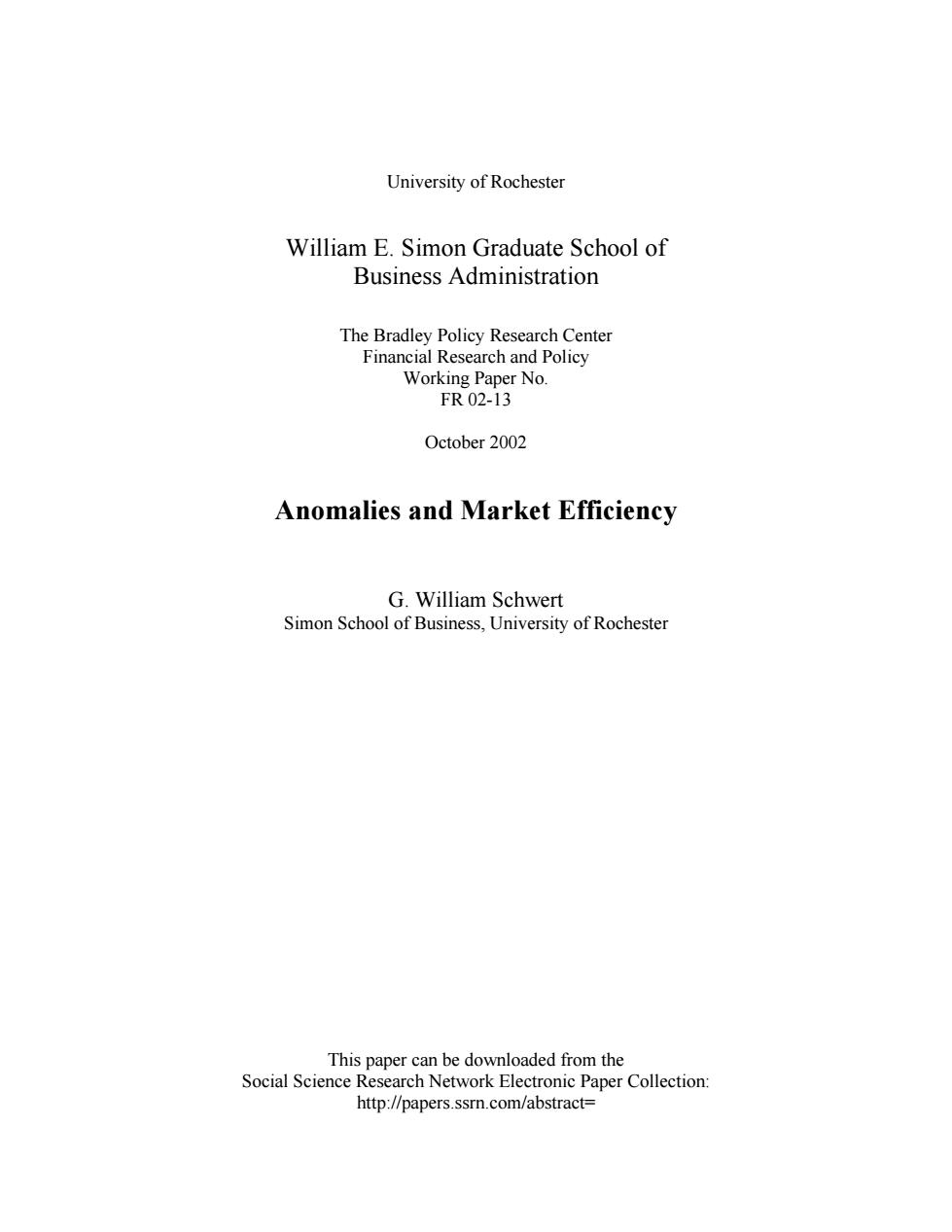
University of Rochester William E.Simon Graduate School of Business Administration The Bradley Policy Research Center Financial Research and Policy Working Paper No. FR02-13 October 2002 Anomalies and Market Efficiency G.William Schwert Simon School of Business,University of Rochester This paper can be downloaded from the Social Science Research Network Electronic Paper Collection: http://papers.ssrn.com/abstract=
University of Rochester William E. Simon Graduate School of Business Administration The Bradley Policy Research Center Financial Research and Policy Working Paper No. FR 02-13 October 2002 Anomalies and Market Efficiency G. William Schwert Simon School of Business, University of Rochester This paper can be downloaded from the Social Science Research Network Electronic Paper Collection: http://papers.ssrn.com/abstract=
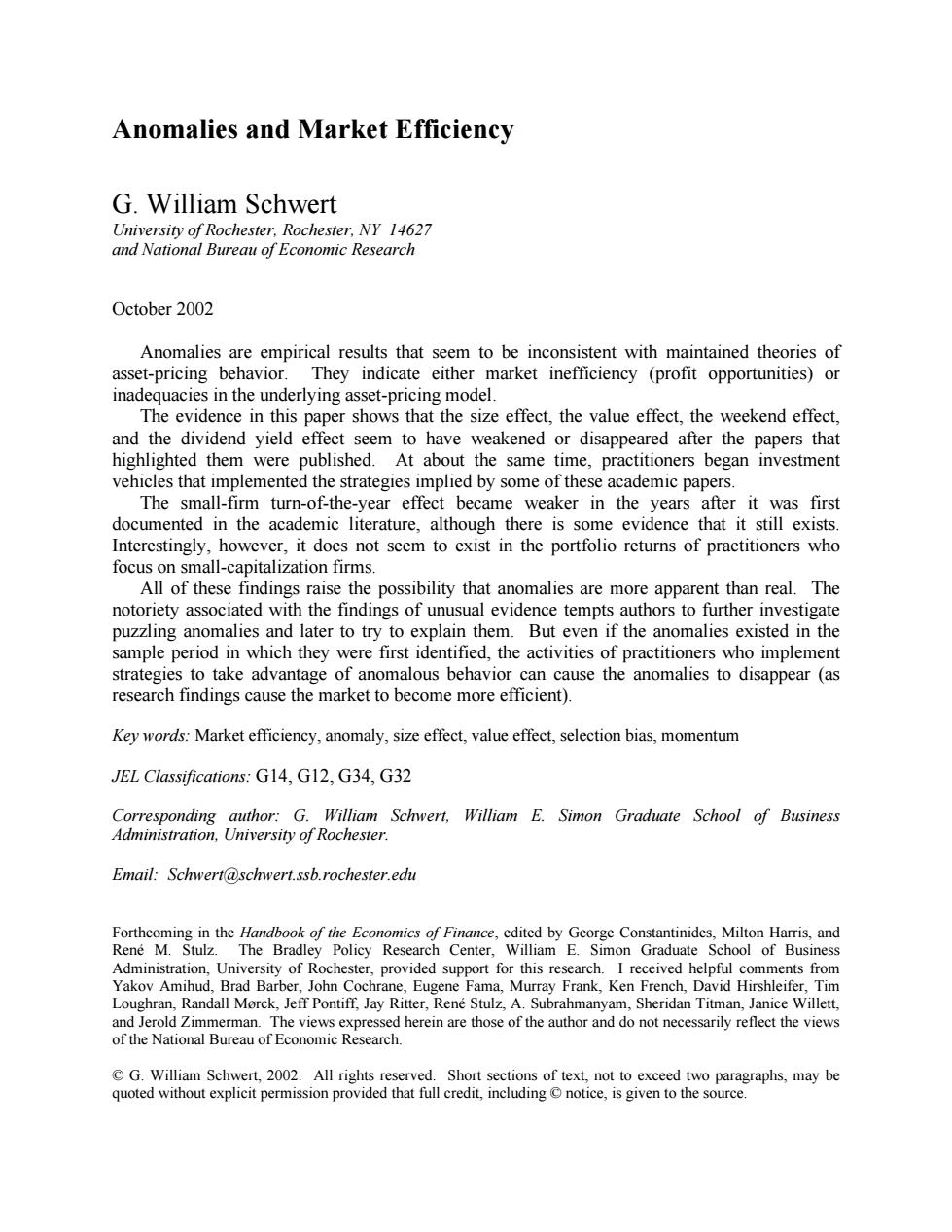
Anomalies and Market Efficiency G.William Schwert University of Rochester,Rochester,NY 14627 and National Bureau of Economic Research October 2002 Anomalies are empirical results that seem to be inconsistent with maintained theories of asset-pricing behavior.They indicate either market inefficiency (profit opportunities)or inadequacies in the underlying asset-pricing model. The evidence in this paper shows that the size effect,the value effect,the weekend effect, and the dividend yield effect seem to have weakened or disappeared after the papers that highlighted them were published.At about the same time,practitioners began investment vehicles that implemented the strategies implied by some of these academic papers. The small-firm turn-of-the-year effect became weaker in the years after it was first documented in the academic literature,although there is some evidence that it still exists. Interestingly,however,it does not seem to exist in the portfolio returns of practitioners who focus on small-capitalization firms. All of these findings raise the possibility that anomalies are more apparent than real.The notoriety associated with the findings of unusual evidence tempts authors to further investigate puzzling anomalies and later to try to explain them.But even if the anomalies existed in the sample period in which they were first identified,the activities of practitioners who implement strategies to take advantage of anomalous behavior can cause the anomalies to disappear (as research findings cause the market to become more efficient). Key words:Market efficiency,anomaly,size effect,value effect,selection bias,momentum JEL Classifications:G14,G12.G34.G32 Corresponding author:G.William Schwert,William E.Simon Graduate School of Business Administration,University of Rochester. Email:Schwert@schwert.ssb.rochester.edu Forthcoming in the Handbook of the Economics of Finance,edited by George Constantinides,Milton Harris,and Rene M.Stulz.The Bradley Policy Research Center,William E.Simon Graduate School of Business Administration,University of Rochester,provided support for this research.I received helpful comments from Yakov Amihud,Brad Barber,John Cochrane,Eugene Fama,Murray Frank,Ken French,David Hirshleifer,Tim Loughran,Randall Morck,Jeff Pontiff,Jay Ritter,Rene Stulz,A.Subrahmanyam,Sheridan Titman,Janice Willett, and Jerold Zimmerman.The views expressed herein are those of the author and do not necessarily reflect the views of the National Bureau of Economic Research. G.William Schwert,2002.All rights reserved.Short sections of text,not to exceed two paragraphs,may be quoted without explicit permission provided that full credit,including notice,is given to the source
Anomalies and Market Efficiency G. William Schwert University of Rochester, Rochester, NY 14627 and National Bureau of Economic Research October 2002 Anomalies are empirical results that seem to be inconsistent with maintained theories of asset-pricing behavior. They indicate either market inefficiency (profit opportunities) or inadequacies in the underlying asset-pricing model. The evidence in this paper shows that the size effect, the value effect, the weekend effect, and the dividend yield effect seem to have weakened or disappeared after the papers that highlighted them were published. At about the same time, practitioners began investment vehicles that implemented the strategies implied by some of these academic papers. The small-firm turn-of-the-year effect became weaker in the years after it was first documented in the academic literature, although there is some evidence that it still exists. Interestingly, however, it does not seem to exist in the portfolio returns of practitioners who focus on small-capitalization firms. All of these findings raise the possibility that anomalies are more apparent than real. The notoriety associated with the findings of unusual evidence tempts authors to further investigate puzzling anomalies and later to try to explain them. But even if the anomalies existed in the sample period in which they were first identified, the activities of practitioners who implement strategies to take advantage of anomalous behavior can cause the anomalies to disappear (as research findings cause the market to become more efficient). Key words: Market efficiency, anomaly, size effect, value effect, selection bias, momentum JEL Classifications: G14, G12, G34, G32 Corresponding author: G. William Schwert, William E. Simon Graduate School of Business Administration, University of Rochester. Email: Schwert@schwert.ssb.rochester.edu Forthcoming in the Handbook of the Economics of Finance, edited by George Constantinides, Milton Harris, and René M. Stulz. The Bradley Policy Research Center, William E. Simon Graduate School of Business Administration, University of Rochester, provided support for this research. I received helpful comments from Yakov Amihud, Brad Barber, John Cochrane, Eugene Fama, Murray Frank, Ken French, David Hirshleifer, Tim Loughran, Randall Mørck, Jeff Pontiff, Jay Ritter, René Stulz, A. Subrahmanyam, Sheridan Titman, Janice Willett, and Jerold Zimmerman. The views expressed herein are those of the author and do not necessarily reflect the views of the National Bureau of Economic Research. © G. William Schwert, 2002. All rights reserved. Short sections of text, not to exceed two paragraphs, may be quoted without explicit permission provided that full credit, including © notice, is given to the source
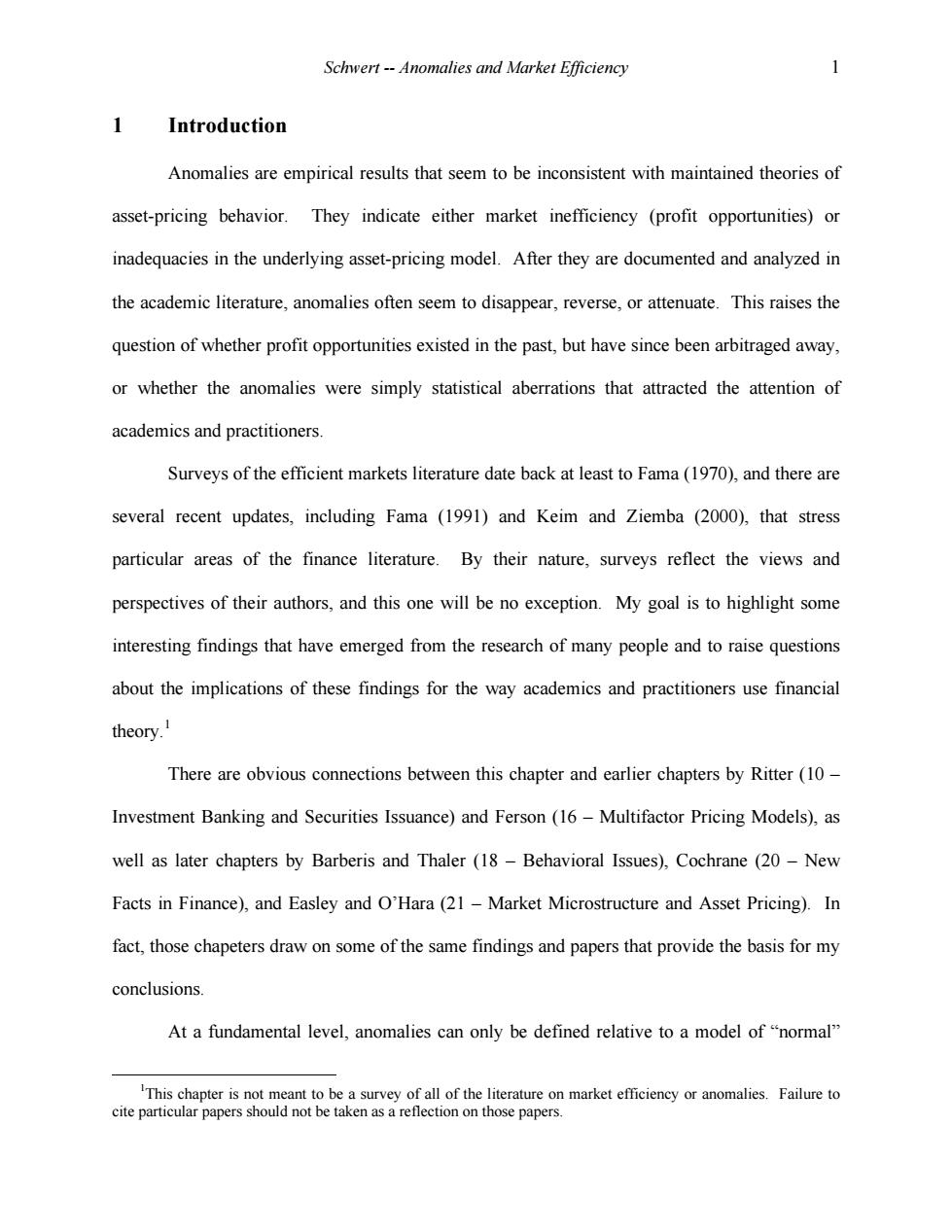
Schwert--Anomalies and Market Efficiency 1 Introduction Anomalies are empirical results that seem to be inconsistent with maintained theories of asset-pricing behavior.They indicate either market inefficiency (profit opportunities)or inadequacies in the underlying asset-pricing model.After they are documented and analyzed in the academic literature,anomalies often seem to disappear,reverse,or attenuate.This raises the question of whether profit opportunities existed in the past,but have since been arbitraged away, or whether the anomalies were simply statistical aberrations that attracted the attention of academics and practitioners. Surveys of the efficient markets literature date back at least to Fama(1970),and there are several recent updates,including Fama (1991)and Keim and Ziemba (2000),that stress particular areas of the finance literature.By their nature,surveys reflect the views and perspectives of their authors,and this one will be no exception.My goal is to highlight some interesting findings that have emerged from the research of many people and to raise questions about the implications of these findings for the way academics and practitioners use financial theory.I There are obvious connections between this chapter and earlier chapters by Ritter(10- Investment Banking and Securities Issuance)and Ferson (16-Multifactor Pricing Models),as well as later chapters by Barberis and Thaler (18-Behavioral Issues),Cochrane (20-New Facts in Finance),and Easley and O'Hara(21-Market Microstructure and Asset Pricing).In fact,those chapeters draw on some of the same findings and papers that provide the basis for my conclusions. At a fundamental level,anomalies can only be defined relative to a model of"normal" This chapter is not meant to be a survey of all of the literature on market efficiency or anomalies.Failure to cite particular papers should not be taken as a reflection on those papers
Schwert -- Anomalies and Market Efficiency 1 1 Introduction Anomalies are empirical results that seem to be inconsistent with maintained theories of asset-pricing behavior. They indicate either market inefficiency (profit opportunities) or inadequacies in the underlying asset-pricing model. After they are documented and analyzed in the academic literature, anomalies often seem to disappear, reverse, or attenuate. This raises the question of whether profit opportunities existed in the past, but have since been arbitraged away, or whether the anomalies were simply statistical aberrations that attracted the attention of academics and practitioners. Surveys of the efficient markets literature date back at least to Fama (1970), and there are several recent updates, including Fama (1991) and Keim and Ziemba (2000), that stress particular areas of the finance literature. By their nature, surveys reflect the views and perspectives of their authors, and this one will be no exception. My goal is to highlight some interesting findings that have emerged from the research of many people and to raise questions about the implications of these findings for the way academics and practitioners use financial theory.1 There are obvious connections between this chapter and earlier chapters by Ritter (10 – Investment Banking and Securities Issuance) and Ferson (16 – Multifactor Pricing Models), as well as later chapters by Barberis and Thaler (18 – Behavioral Issues), Cochrane (20 – New Facts in Finance), and Easley and O’Hara (21 – Market Microstructure and Asset Pricing). In fact, those chapeters draw on some of the same findings and papers that provide the basis for my conclusions. At a fundamental level, anomalies can only be defined relative to a model of “normal” 1This chapter is not meant to be a survey of all of the literature on market efficiency or anomalies. Failure to cite particular papers should not be taken as a reflection on those papers
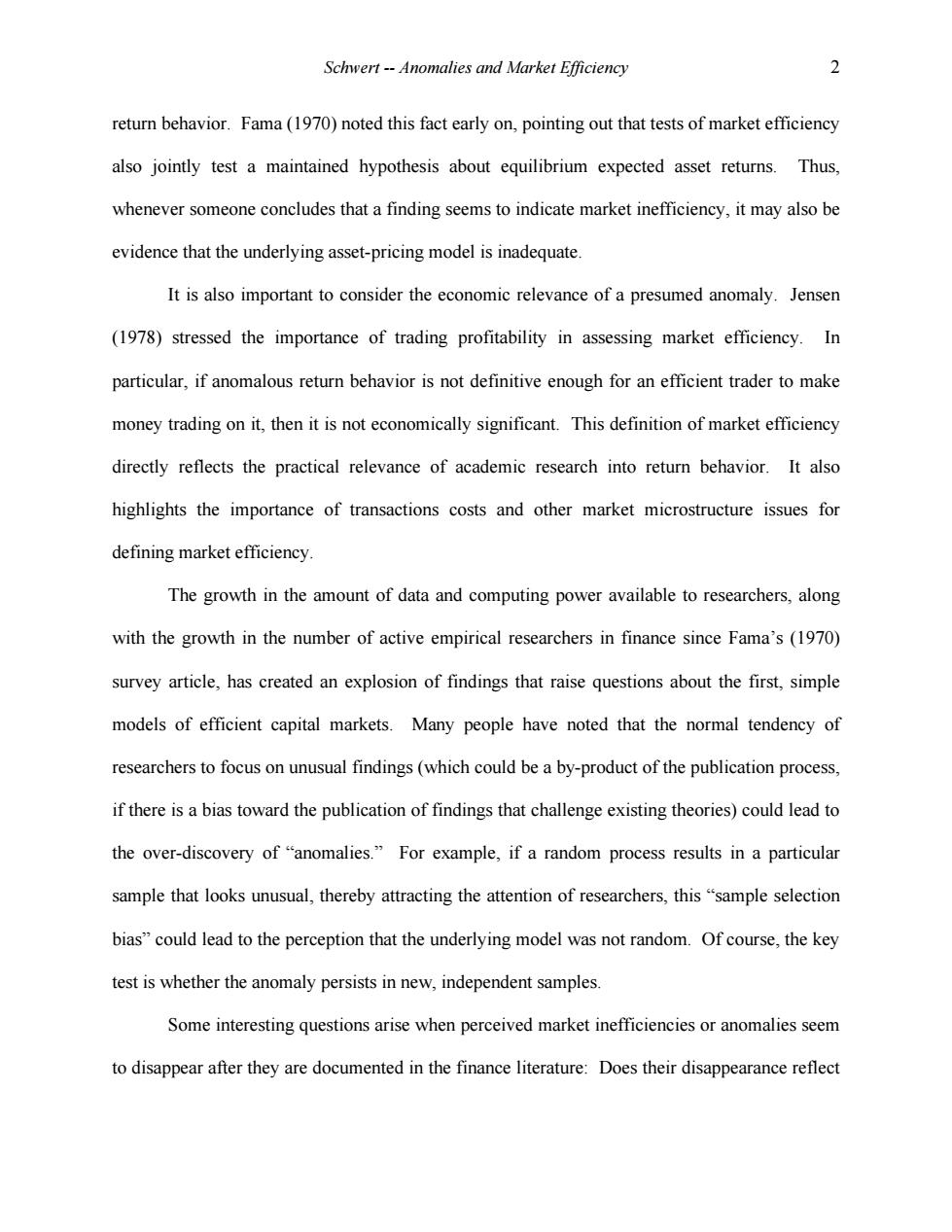
Schwert--Anomalies and Market Efficiency 2 return behavior.Fama(1970)noted this fact early on,pointing out that tests of market efficiency also jointly test a maintained hypothesis about equilibrium expected asset returns.Thus, whenever someone concludes that a finding seems to indicate market inefficiency,it may also be evidence that the underlying asset-pricing model is inadequate. It is also important to consider the economic relevance of a presumed anomaly.Jensen (1978)stressed the importance of trading profitability in assessing market efficiency.In particular,if anomalous return behavior is not definitive enough for an efficient trader to make money trading on it,then it is not economically significant.This definition of market efficiency directly reflects the practical relevance of academic research into return behavior.It also highlights the importance of transactions costs and other market microstructure issues for defining market efficiency. The growth in the amount of data and computing power available to researchers,along with the growth in the number of active empirical researchers in finance since Fama's(1970) survey article,has created an explosion of findings that raise questions about the first,simple models of efficient capital markets.Many people have noted that the normal tendency of researchers to focus on unusual findings(which could be a by-product of the publication process, if there is a bias toward the publication of findings that challenge existing theories)could lead to the over-discovery of"anomalies."For example,if a random process results in a particular sample that looks unusual,thereby attracting the attention of researchers,this"sample selection bias"could lead to the perception that the underlying model was not random.Of course,the key test is whether the anomaly persists in new,independent samples Some interesting questions arise when perceived market inefficiencies or anomalies seem to disappear after they are documented in the finance literature:Does their disappearance reflect
Schwert -- Anomalies and Market Efficiency 2 return behavior. Fama (1970) noted this fact early on, pointing out that tests of market efficiency also jointly test a maintained hypothesis about equilibrium expected asset returns. Thus, whenever someone concludes that a finding seems to indicate market inefficiency, it may also be evidence that the underlying asset-pricing model is inadequate. It is also important to consider the economic relevance of a presumed anomaly. Jensen (1978) stressed the importance of trading profitability in assessing market efficiency. In particular, if anomalous return behavior is not definitive enough for an efficient trader to make money trading on it, then it is not economically significant. This definition of market efficiency directly reflects the practical relevance of academic research into return behavior. It also highlights the importance of transactions costs and other market microstructure issues for defining market efficiency. The growth in the amount of data and computing power available to researchers, along with the growth in the number of active empirical researchers in finance since Fama’s (1970) survey article, has created an explosion of findings that raise questions about the first, simple models of efficient capital markets. Many people have noted that the normal tendency of researchers to focus on unusual findings (which could be a by-product of the publication process, if there is a bias toward the publication of findings that challenge existing theories) could lead to the over-discovery of “anomalies.” For example, if a random process results in a particular sample that looks unusual, thereby attracting the attention of researchers, this “sample selection bias” could lead to the perception that the underlying model was not random. Of course, the key test is whether the anomaly persists in new, independent samples. Some interesting questions arise when perceived market inefficiencies or anomalies seem to disappear after they are documented in the finance literature: Does their disappearance reflect
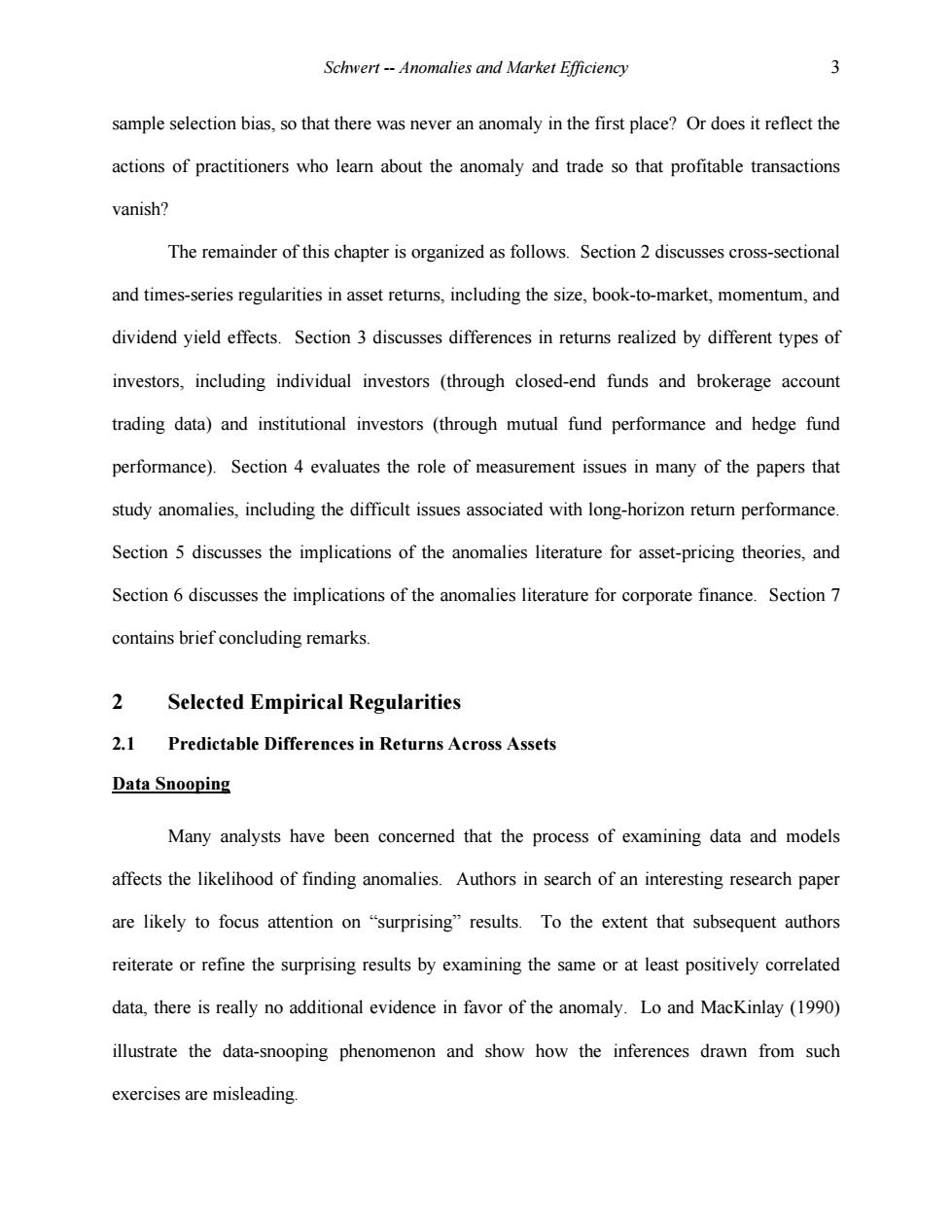
Schwert--Anomalies and Market Efficiency 3 sample selection bias,so that there was never an anomaly in the first place?Or does it reflect the actions of practitioners who learn about the anomaly and trade so that profitable transactions vanish? The remainder of this chapter is organized as follows.Section 2 discusses cross-sectional and times-series regularities in asset returns,including the size,book-to-market,momentum,and dividend yield effects.Section 3 discusses differences in returns realized by different types of investors,including individual investors (through closed-end funds and brokerage account trading data)and institutional investors (through mutual fund performance and hedge fund performance).Section 4 evaluates the role of measurement issues in many of the papers that study anomalies,including the difficult issues associated with long-horizon return performance. Section 5 discusses the implications of the anomalies literature for asset-pricing theories,and Section 6 discusses the implications of the anomalies literature for corporate finance.Section 7 contains brief concluding remarks. 2 Selected Empirical Regularities 2.1 Predictable Differences in Returns Across Assets Data Snooping Many analysts have been concerned that the process of examining data and models affects the likelihood of finding anomalies.Authors in search of an interesting research paper are likely to focus attention on "surprising"results.To the extent that subsequent authors reiterate or refine the surprising results by examining the same or at least positively correlated data,there is really no additional evidence in favor of the anomaly.Lo and MacKinlay (1990) illustrate the data-snooping phenomenon and show how the inferences drawn from such exercises are misleading
Schwert -- Anomalies and Market Efficiency 3 sample selection bias, so that there was never an anomaly in the first place? Or does it reflect the actions of practitioners who learn about the anomaly and trade so that profitable transactions vanish? The remainder of this chapter is organized as follows. Section 2 discusses cross-sectional and times-series regularities in asset returns, including the size, book-to-market, momentum, and dividend yield effects. Section 3 discusses differences in returns realized by different types of investors, including individual investors (through closed-end funds and brokerage account trading data) and institutional investors (through mutual fund performance and hedge fund performance). Section 4 evaluates the role of measurement issues in many of the papers that study anomalies, including the difficult issues associated with long-horizon return performance. Section 5 discusses the implications of the anomalies literature for asset-pricing theories, and Section 6 discusses the implications of the anomalies literature for corporate finance. Section 7 contains brief concluding remarks. 2 Selected Empirical Regularities 2.1 Predictable Differences in Returns Across Assets Data Snooping Many analysts have been concerned that the process of examining data and models affects the likelihood of finding anomalies. Authors in search of an interesting research paper are likely to focus attention on “surprising” results. To the extent that subsequent authors reiterate or refine the surprising results by examining the same or at least positively correlated data, there is really no additional evidence in favor of the anomaly. Lo and MacKinlay (1990) illustrate the data-snooping phenomenon and show how the inferences drawn from such exercises are misleading